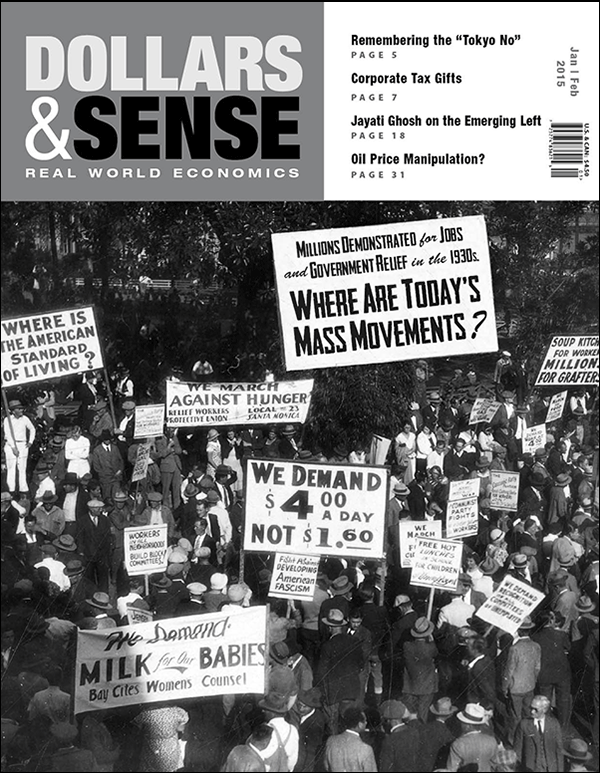The Motherhood Gamble
While many mothers enjoy adequate support from fathers, the risk of financial hardship looms large if the partnership comes to an end.

New Issue! Our Jan/Feb 2015 issue is (finally) out--or at least it is ready to be sent to the printers tomorrow. (E-subscribers will get their pdf by email tomorrow also.) We posted John Miller's "Up Against the Wall Street Journal" column today: Another Gift for Corporations--Lower Tax Rates, timely because of Obama's discussion of tax reform in the State of the Union (more on the SOTU when I get a chance to post some links that have been accumulating on my desk). There is lots else to enjoy in this issue. Here is our p. 2 editors' note:
Almost by definition, those who are battling the wealthy and powerful are normally going to be on the defensive. Being the wealthy and powerful is like holding the high ground in a battle. It makes it easier to repel any challenges. And it means that you must have won battles in the past, or you wouldn’t still have the high ground.
Seeking to understand and explain why society is how it is—what we try to do at Dollars & Sense—means confronting, over and over, why the other side is winning, how they occupy the high ground. But it’s a task that can give rise not only to despair, but also to hope: Ask “why is the world how it is?” and you’re liable to end up asking “well, why isn’t it different?”
In this issue, Deborah M. Figart and Thomas Barr look at the growing world of check-cashing outlets (CCOs). With a mostly low-income clientele not well-served by regular banks, check-cashing is an industry rife with the possibility of predatory practices and extortionate fees. So why isn’t that always the case? Figart explains that the story varies a great deal from one state to another, and that the difference is effective (and effectively enforced) regulation.
Gertrude Schaffner Goldberg takes a look back at the mass upsurge of the Great Depression era—the labor struggles that created large industrial unions and the lesser-known movements of the unemployed—and why we haven’t seen anything on a comparable scale during our Great Recession. She argues that the underlying conditions of the present era, while not as severe as the 1930s, were enough to create a much larger upsurge than actually happened. The missing ingredients have been even modestly supportive government policies and cohesive, ideologically committed groups of organizers.
Robin Broad shows us an example to emulate—the 1964 “Tokyo No,” in which 19 lower-income countries opposed a World Bank proposal to create a tribunal where investors could sue governments, sidestepping national courts. While the tribunal system still went through, this is no mere nostalgia for past defiance. The issue of “investor-stage dispute settlement” is ever more pressing, as such institutions have grown in power, and is provoking renewed defiance today.
Economist Jayati Ghosh points to the obstacles standing in the way of economic development and labor solidarity, and yet offers an optimistic and ambitious vision of the world that could be: where “your life chances are not fundamentally different because of accidents of birth. So if you are born as a girl of a minority ethnic group in a rural area of a poor region, you would still have access to minimum conditions of life and opportunities for developing your capabilities that are not too different from a boy born in a well-off household of a dominant social group in an affluent society.”
So, how do we get there from here? We do not have mass movements in the United States today at the scale of the 1930s. To give but one example, in 1934 and again in 1937, the percentage of all employed workers involved in a work stoppage was over 7%, a figure exceeded for only three years in the next half century. There are, however, nascent movements impacting U.S. political life in important ways. The Occupy Movement sounded a battle cry over the growing abyss of income and wealth inequality—giving us a new lexicon of the “1%” and the “99%.” Movements like Our Walmart and the Fight for 15 are showing that workers in low-wage industries like fast food and retail will not take low pay and abusive working conditions lying down. The Black Lives Matter movement is fighting back against the racist and repressive face of the state. (We should note, too, hopeful developments on the world scene: Leftist parties like SYRIZA in Greece and Podemos (We Can) in Spain, for example, are on the rise, offering alternatives not only to business neoliberalism and right-wing populism, but also to center-left parties that have done the dirty work of austerity.)
The movements of today are, perhaps, less akin to those of the Depression era than to those that persisted between the Red Scare and the Great Crash—that, even under assault by employers and the state, laid the groundwork for mass risings of the next decade. The challenge, now, is to build these movements, as Goldberg describes, into mass movements of millions, and to imbue them, as Ghosh proposes, with the vision of a new society that only they can make.
Links on SOTU, Black Lives Matter, the economics profession, the Van Hollen plan, and other stuff soon!
--Chris Sturr